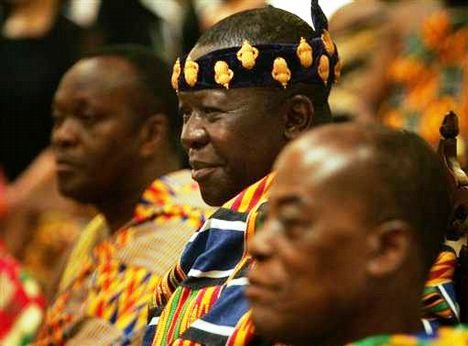![]()
The Words of the Osei Family
|
|
The Words of the Osei Family |

Kumasi, Ghana - On the annual day of celebration among the Ashanti people of central Ghana, many people and groups gathered to pay homage to King Otumfuo Osei Tutu II. The President of the Council of Chiefs described the work of UPF to build peace around the world, and then an Ambassador for Peace certificate was presented to the king.
Twice before he had been contacted and invited to participate in UPF’s International Leadership Conferences in the USA but he could not make it due to a schedule conflict. When the information was received about this year’s October 14 International Leadership Conference in Korea, he was again contacted and showed much interest. However, it was learned that protocol requires that he travel with an entourage of 16 people. Since funds were not available to cover the additional costs, he was unable to make the trip.
To explore other ways to develop a relationship, we set off for Kumasi to meet with the President of the Ashanti Council of Chiefs, Nana Ameyaw Kotoko II, who was assigned by His Royal Majesty to receive us on his behalf.
Plans were made to present the King with an Ambassador for Peace certificate at a meeting with all the Paramount Chiefs in the region on December 9, to assess their accomplishments during the year. We gave him printed materials about the activities of UPF worldwide, and he gave us instructions about other gifts to prepare for a royal audience.
Kumasi rose to prominence in 1695 when it became capital of the Ashanti Empire due to the activities of its ruler Osei Tutu. The empire extended from central Ghana to present day Togo and Côte d'Ivoire and grew wealthy through trading in gold. Parts of the city, including the Royal Palace, were destroyed by British troops in the Fourth Anglo-Ashanti War of 1874. With its current population of 1.5 million, it remains a royal city, although since all of Ghana was declared independent in 1957, the role of king has been mainly symbolic.
A four-person delegation including three headquarters staff and one Ambassador for Peace left early in the morning for the 100-mile trip to the Manhyia Palace, which usually takes about five hours. We were scheduled to meet the King at 11:00 am, but we did not arrive until 2:00 pm because of traffic delays. As a result, we were placed last on the schedule.
December 9 was an annual day of celebration in the region, and many people and groups came to pay homage to the King in the traditional royal residence, which is now a museum. They took turns standing as a group in front of the King while the leader of that group made a brief presentation; then they moved forward to shake hands with the King.
When we were called to make our presentation, Nana Kotoko introduced UPF’s activities worldwide, and both of us presented the Ambassador for Peace certificate to the King’s representative. I was asked to move forward to shake hands with the King while those with me introduced themselves and offered a half bow to the King.
In response, the King expressed his gratitude to the Universal Peace Federation, stating that he is a man of peace and as such will give maximum support to peace activities in the region.
Our presentation brought the entire gathering to a close. According to tradition, everyone in the hall stood to form a large circle, and the King stepped forward with his chiefs and walked around the circle shaking hands with all the people in the front row. Nana Kotoko had arranged for an opportunity for me to shake the King’s hand and have a photo taken together. Then the King and his officials retired to his inner chamber while the audience dispersed